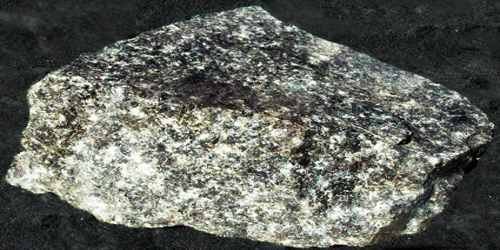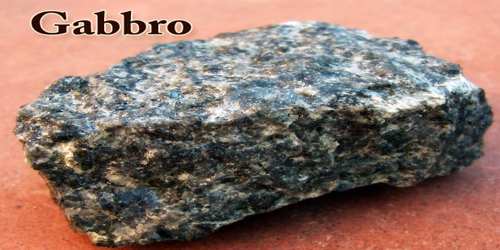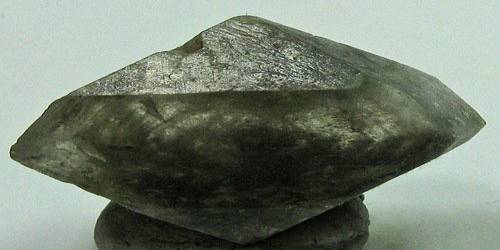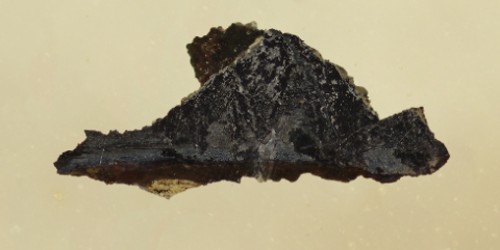Definition –
Gabbro (/ˈɡæbroʊ/) is a phaneritic (coarse-grained), is an intrusive igneous rock that forms from the result of slow cooling of magma inside of a volcano. It is very similar to the fast cooling, extrusive basalt, as they both are formed from mafic magmas that contain dark-colored minerals such as pyroxene, plagioclase, amphibole, and olivine.
Essentially, gabbro is the intrusive (plutonic) equivalent of basalt, but whereas basalt is often remarkably homogeneous in mineralogy and composition, gabbros are exceedingly variable. Gabbros are found widely on the Earth and on the Moon as well. Gabbros are sometimes quarried for dimension stone (the black granite of commerce), and the San Marcos Gabbro of southern California is used for gauge blocks, but the direct economic value of gabbro is minor. Far more important are the primary mineralization of nickel, chromium, and platinum that occur almost exclusively in association with gabbroic or related ultramafic (very silica-poor) rocks. Primary magnetite (iron) and ilmenite (titanium) mineralization are often intimately associated with gabbroic complexes.
Slow-cooling, coarse-grained gabbro is chemically equivalent to rapid-cooling, fine-grained basalt. Much of the Earth’s oceanic crust is made of gabbro, formed at mid-ocean ridges. Gabbro is also found as plutons associated with continental volcanism. Due to its variant nature, the term “gabbro” may be applied loosely to a wide range of intrusive rocks, many of which are merely “gabbroic”.
Gabbro is the most abundant rock in the deep oceanic crust. It is sometimes called “black granite” for it too is coarse-grained, but a large proportion of iron-bearing minerals make gabbro heavier and dark-colored. Gabbro can also be gray or light green. It has a variety of uses in the construction industry. It is used for everything from crushed stone base materials at construction sites to polished stone countertops and floor tiles.

Occurrences and Petrology of Gabbro –
Banded, or layered, gabbroic complexes in which moon mineral or bimineral varieties are well developed have been described from Montana, the Bushveld in South Africa, and the island of Skye. There are also gabbro complexes that are locally streaky and inhomogeneous and are not regularly layered, as the large, basinlike intrusion at Sudbury, Ont., and some of the larger diabase sills (tabular intrusions), as at Beaver Bay, Minn.; the Palisades, New Jersey; and many of the Karoo (Karroo) diabases in South Africa.
The most important minerals in the gabbro are plagioclase and pyroxene. plagioclase often appear more. It is a small amount of olivine and amphibole. Plagioclase is sodium-calcium feldspar. Gabbro contains more calcium than sodium. If there is more sodium in the plagioclase, then the rock type is called diorite. Gabbro is greenish and dark.
The pyroxene content is mostly clinopyroxene, generally augite, but small amounts of orthopyroxene may also be present. If the amount of orthopyroxene is more than 95% of the total pyroxene content (5% or less clinopyroxene content), then the rock is termed norite. On the other hand, gabbro has more than 95% of its pyroxenes in the form of the monoclinic clinopyroxene/s. Intermediate rocks are termed gabbro-norite. The calcium-rich plagioclase feldspar (labradorite-bytownite) and pyroxene content vary between 10-90% in gabbro. If more than 90% of plagioclase is present, then the rock is an anorthosite. If on the other hand, the rock contains more than 90% pyroxenes (often both are present), it is termed pyroxenite.
Gabbro occurs when the liquid rock is cooled very slowly over a long period of time in the underground. This is an intrusive magmatic rock and is close to the very hot core of the world, which is why it takes longer to cool, and therefore the rock is visibly very different from the opposite of the basalt. The crystals are very large and clear to the naked eye and the texture is very coarse. This coarse-grained texture can be labeled porphyric or a mixture of large and finer-grained crystals, which are very large crystals. The time required for the liquid rock to cool will determine the texture.
Gabbro may also contain small amounts of olivine (“olivine gabbro” if substantial amount of olivine is present), amphibole and biotite. The quartz content in gabbro is less than 5% of total volume. ‘Quartz gabbros’ or monzogabbros are also known to occur, for example, the cizlakite at Pohorje in northeastern Slovenia, and are probably derived from magma that was over-saturated with silica. Essexites represent gabbros whose parent magma was under-saturated with silica, resulting in the formation of the feldspathoid minerals nepheline, cancrinite, and sodalite as accessory minerals rather than quartz. (Silica saturation of a rock can be evaluated by normative mineralogy). Gabbros contain minor amounts, typically a few percent, of iron-titanium oxides such as magnetite, ilmenite, and ulvospinel.
Formation –
Gabbro forms in an intrusive setting, from the cooling and crystallization of magma underneath Earth’s surface. Because it has a long time to cool, its crystals grow much larger than the crystals in its extrusive equivalent, basalt, do. Gabbros are commonly found underground in the vicinity of volcanoes, as well as in oceanic crust near mid-ocean ridge spreading centers. It contains a variety of dark colored minerals that are classified by geologists as being mafic. These minerals include pyroxene, plagioclase, amphibole, and olivine. They can also contain small amounts of iron-titanium oxides.
Gabbro is generally coarse grained, with crystals in the size range of 1 mm or greater. Finer grained equivalents of gabbro are called diabase (also known as dolerite), although the term micro gabbro is often used when extra descriptiveness is desired. Gabbro may be extremely coarse-grained to pegmatitic, and some pyroxene-plagioclase cumulates are essentially coarse-grained gabbro, some may exhibit acicular crystal habits. It is usually equigranular in texture, although it may be porphyritic at times, especially when plagioclase oikocrysts have grown earlier than the groundmass minerals.
A lopolith at Duluth, Minn., is a notable exception to the rather arbitrary division between layered and unlayered gabbro complexes. The lower part of this mass has the average composition of an olivine gabbro but is strongly banded, with individual bands that vary in composition from anorthosite to peridotite (monomineralic rocks that contain labradorite and olivine). The upper portion is a comparatively homogeneous feldspathic gabbro, locally patchy and streaky but not sharply banded. Between the two major divisions, and again at the top of the feldspathic gabbro, is a zone of granophyre or micropegmatitic granite.
Uses of Gabbro –
Gabbro often contains valuable amounts of chromium, nickel, cobalt, gold, silver, platinum, and copper sulfides. It is an essential part of the oceanic crust and can be found in many ophiolite complexes as parts of zones III and IV (sheeted dyke zone to massive gabbro zone). Long belts of gabbroic intrusions are typically formed at proto-rift zones and around ancient rift zone margins, intruding into the rift flanks. Mantle plume hypotheses may rely on identifying mafic and ultramafic intrusions and coeval basalt volcanism.
Bright polished gabbro cemetery signs are used in kitchen stalls, floor tiles, facade stone, and other size stone products. It is a highly desirable rock based on weather and wear. In the stone industry size gabbro is sold under the name “black granite”. Gabbro is also used to make a large number of rough cut products, such as borders, stones, paving stones and other products. The most common use of gabbro is like crushed stone or aggregate. The crushed gabbro is used as a basic material in construction projects, as a crushed stone for road construction, as a railway ballast and as a filler where a resistant crushed stone is needed.
Information Sources:
















